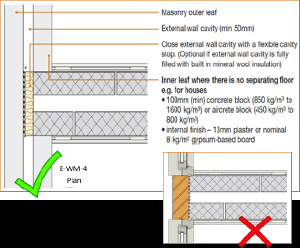Making a Return to Cavity Separating Walls

Preventing noise from getting round the end of a separating wall is every bit as important as stopping it from going directly through – and this is where the flanking junctions come into play.
But these junctions can become compromised when there is full-width glazing; or when the front doors of handed terraced houses are positioned tight against the separating wall.
What's the flanking point?
To give the required flanking performance, all Robust Details walls specify that a return has to be constructed at the end of the separating wall (using the specified materials) to create a ‘T’-shaped cavity.
 Forming the junction in this way means the two leafs of the separating wall can remain structurally disconnected; and even if door frames and rigid closers bridge the external cavity, the dissimilar materials and more complex transmission path means it is much harder for sound to track across from one side to the other – thus maintaining isolation.
Forming the junction in this way means the two leafs of the separating wall can remain structurally disconnected; and even if door frames and rigid closers bridge the external cavity, the dissimilar materials and more complex transmission path means it is much harder for sound to track across from one side to the other – thus maintaining isolation.
Size Matters
There is no minimum length specified for the flanking wall return in the Robust Details – so does it matter? Well, yes. The main consideration being that the return is sized to meet other regulations and standards, such as those relating to structure – not only in relation to the stability of the external wall sections at that point, but also that the return is sufficiently long to take the full bearing of associated lintels. If the lintels were to go into or through the thickness of the separating wall leaf, this could create a flanking path through the wall – especially where hollow lintels are used.
If you have any techncial enquiries please do not hesitate to contact our technical team on 03300 882140 or email: technical@robustdetails.com
Return to the Top Tips page

